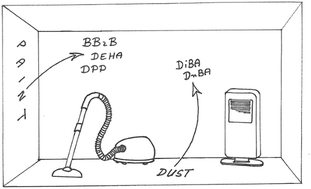Distribution of five SVOCs in a model room: effect of vacuuming and air cleaning measures†
Abstract
With regard to the application of semi-volatile organic compounds (SVOCs) in products for indoor use, a distinct trend towards substitutions can currently be observed. Among the possible phthalate alternatives, in particular the adipic acid esters have gained in market importance. The chemical–physical and thermodynamic properties of the phthalates and adipates allow the conclusion to be drawn that they are distributed between different compartments (gas phase, particle phase, dust, material surfaces) of the indoor space. There are, however, hardly any data in existence which were collected in a real environment over six months and longer. Diisobutyl adipate (DiBA), di-n-butyl adipate (DnBA), dipentyl phthalate (DPP), butyl benzyl phthalate (BBzP) and di-2-ethylhexyl adipate (DEHA) were selected as model substances. By means of spiked latex paint and spiked house dust, these SVOCs were introduced into two identically equipped test rooms. One room was cleaned regularly, whilst the reference room was not entered for a 133 day experimental period. The concentrations of the five target substances were determined in the air and in material samples (carpet, vacuum-cleaner bags, filters). During the operation of an air purifier, the air concentration of the target substances in a room could be reduced by more than 50%. In the reference room, a correlation between the logarithmic air concentration and the reciprocal room temperature was found. The results show with great clarity the complexity of the conditions in an indoor room. Models can therefore depict the exposure as a statistical average but not, however, describe the individual case.

- This article is part of the themed collection: Indoor Air: Sources, Chemistry and Health Effects


 Please wait while we load your content...
Please wait while we load your content...